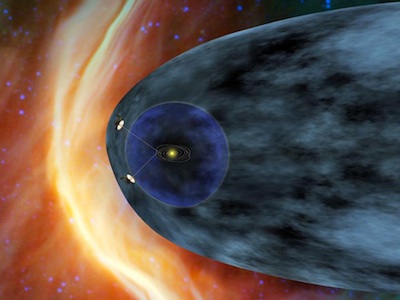BY STEPHEN CLARK
SPACEFLIGHT NOW
Posted: September 16, 2012

More than 35 years after launching from Earth and now at the frontier of the solar system, NASA's Voyager 1 probe may be tasting interstellar space for the first time, according to scientists analyzing fresh data from the distant explorer.

Artist's concept of the Voyager spacecraft. Credit: NASA/JPL-Caltech
Launched in September 1977 to fly past Jupiter and Saturn, Voyager 1 is now cruising 11.3 billion miles away and opening its distance by 300 million miles each year.
It takes 17 hours for a radio signal to travel between Earth and Voyager 1. Its twin explorer - Voyager 2 - is lagging slightly behind at a distance of 9.2 million miles from Earth.
The nuclear-powered probe's computers have about 68 kilobytes of memory. An 8-gigabyte iPod Nano holds more than 100,000 times as much data.
But particle-sniffing sensors aboard Voyager 1 are returning intriguing data showing the spacecraft is in the precipice of leaving the solar system.
Researchers may be seeing the first signs that Voyager 1 is nearing - or may have already crossed - the heliopause, an enigmatic boundary between the sun's sphere of influence and the void beyond.
The sun's million-mile-per-hour solar wind blows a teardrop-shaped bubble around the solar system, pushing against a stream of galactic particles coming from ancient stellar explosions.
The heliosphere is compressed by the galactic wind in one direction, while it stretches behind the solar system like a comet's tail.
The heliosphere blocks most dangerous cosmic radiation from reaching Earth.
"Inside the heliopause, the wind is from the sun, and outside the wind is from the explosion of supernovae," said Ed Stone, project scientist for the Voyager program at NASA's Jet Propulsion Laboratory. "It's a distinctly different part of the universe, and these two spacecraft will be the first to enter interstellar space."
Voyager 1 crossed into the heliosheath in 2004, entering a region where the pressure from galactic particles begin to slow the speed of the solar wind.
Since then, scientists have played a waiting game. No one knows for sure what environment Voyager 1 will encounter when it makes its grand exit.
"We could be actually in interstellar space right now, as far as we know," said Alan Cummings, a senior scientist at the California Institute of Technology, in remarks last month.
But it will take time before scientists can safely conclude Voyager 1 has crossed into the interstellar medium, a domain more dominated by particles from elsewhere in the Milky Way galaxy than from the sun.
At the very least, recent data show Voyager 1 has entered a new region, according to Ed Stone, Voyager's project scientist at NASA's Jet Propulsion Laboratory.
In May, Voyager 1's particle counter began scooping up more high-energy cosmic rays coming from outside the solar system.
"Suddenly, in one month, they increased as much as they had in a year," Stone said. "Obviously, something had changed."
Another, even sharper, rise in high-energy cosmic rays was measured in late August, just as Voyager 1's telescopes detected a dramatic drop in low-energy particles coming from inside the heliosphere.

Diagram of the heliosphere, with the locations of the Voyager 1 and Voyager 2 spacecraft at left. Credit: NASA/JPL-Caltech
The signature closely mirrors what officials expected to see as Voyager 1 neared the heliopause, and the evidence in recent data account for two of three important tests Voyager scientists will use to determine whether the spacecraft has crossed over.
The other indicator is a change in the direction of the magnetic field around Voyager 1, and that is the most difficult to ascertain, according to Stone, who has been with the project since its launch.
According to Stone, confirming the change in magnetic field could take weeks or months of observations.
"There is some kind of connection between where Voyager is and the outside, which lets that are inside out and lets the particles that our outside in," Stone said. "The question is how much further is it to the heliopause? We don't know whether these are special filaments connecting to the outside or whether we're dancing along a new region which is connected to the outside."
Researchers believe the heliopause boundary is extraordinarily turbulent, and its location can fluctuate in location and time. Charged particles travel along magnetic field lines, which can undergo dynamic bursts known as reconnection, much like the process responsible for auroras on Earth.
"This is very new data, and we haven't really digested it all yet," Cummings said. "It could be that the magnetic field line that Voyager is on is making intermittent connections with the heliopause, or this boundary we're trying to get to."
Off-and-on magnetic connections with the heliopause could allow particles from inside the heliosphere to escape and draw in cosmic ways from interstellar space.
"If there's one thing we've learned from Voyager, it's no matter how clever we think we are about the signatures, there's almost surely to be something we haven't figured out when we get there, and that's going to be the most interesting thing of all," Stone said.


No comments:
Post a Comment